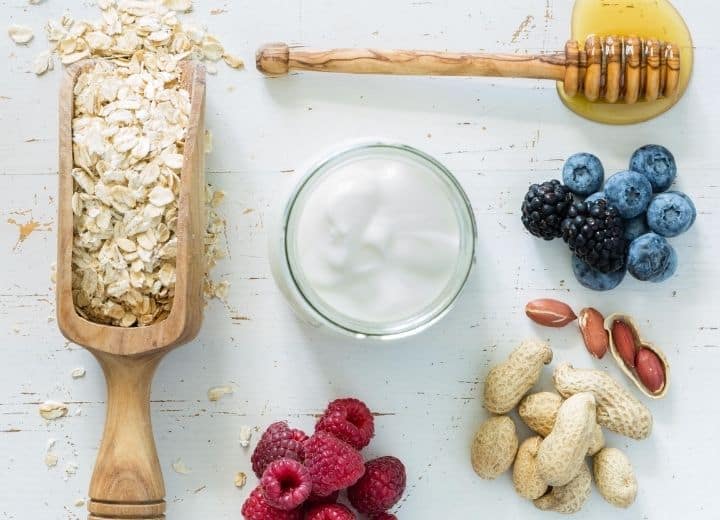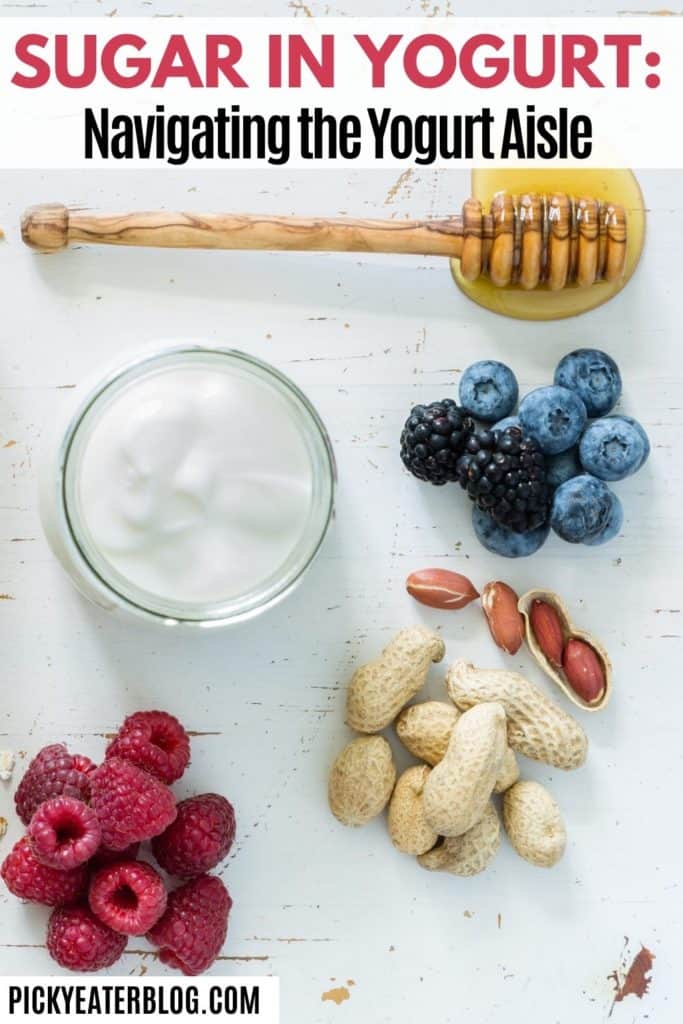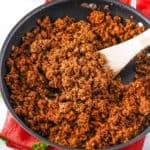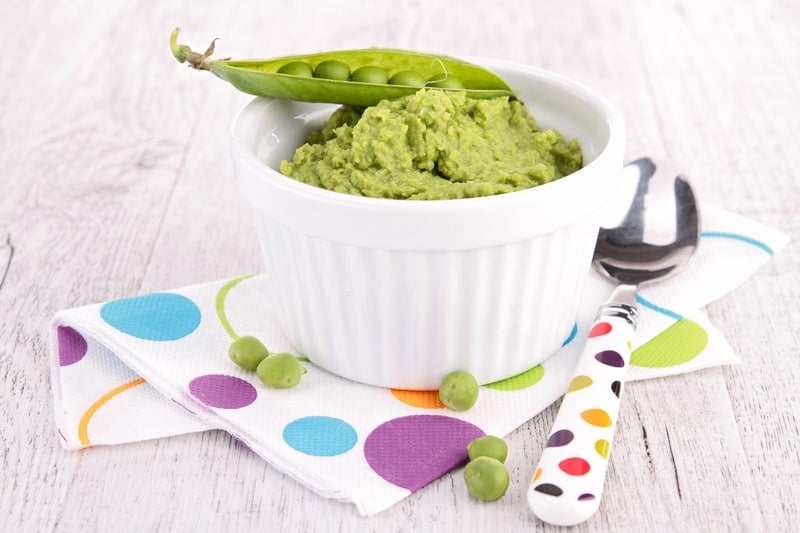Sugar in Yogurt: Navigating the Yogurt Aisle
This post may contain affiliate links. As an Amazon Associate, I earn from qualifying purchases. Please read my disclosure.A complete guide to sugar in yogurt to help you find the best, healthy yogurt option for you. Which brands are the best, and which to avoid!

Greek. Icelandic. Swiss. Fruit flavored. Fruit at the bottom. Nonfat. Lowfat. Full-fat. Soy yogurt. Almond yogurt. Sheep’s milk. Goat’s milk. Organic. All-Natural.
Have you ever stood in front of the yogurt aisle just completely overwhelmed by all of the choices?
I definitely have!
Once upon a time, yogurt was probably limited to plain or vanilla, with maybe a couple of brands to choose from. Today, the yogurt aisle is staggeringly long, with what seems like hundreds of different choices, brands, flavors, and textures — all of which claim to be “healthy.”
And of course, yogurt is a healthier choice for a snack than, say, a can of soda (although some yogurts, with the amount of sugar in them, come pretty close to that can of soda!)
But because it can be SO confusing, I thought I’d create this guide to help you navigate the yogurt aisle – with my tips and tricks for figuring out which yogurt is right for you, and a list of my favorite brands!
Why Is Yogurt Good For You?
- It’s a decent source of vegetarian protein that’s low in calories.
- It is a good source of calcium.
- It contains good-for-you bacteria – known as “probiotics” or “live and active cultures” that can help improve digestion and regulate your immune system.
- It contains Vitamin D (which helps boost calcium absorption).
- And it tastes good!

Why Are Some Yogurts Bad For You?
Not all yogurt is good for you! I know that may come as a shock. But most of the yogurts that are on grocery store shelves, are not a health food, even though their packaging claim otherwise.
- Most yogurts are high in sugar. All yogurt has some natural occurring sugars, but most have added sugars in the form of fruit on the bottom, fruit mixed in, added ingredients such as chocolate chips, or cookies (flip yogurts), etc. While the natural occurring sugars are okay for you, the added sugars are enough for your daily recommended 24 grams or less. For example, Dannon Fruit on the Bottom yogurts can have as many as 24 grams of sugar per serving.
- Artificial sweeteners are also commonly found in yogurt. Studies have shown that artificial sweeteners can raise blood sugar levels, insulin levels, and may cause type 2 diabetes. They are 200 to 600 times sweeter than regular sugar. They can effect your hormone levels, and slow your metabolism.
- Both sugar and artificial sugars are addictive. The more you have them the more you desire to have more. Eating sweetened yogurts can cause you to crave more sweets throughout the day.
Why Should You Care About Sugar In Yogurt?
I know there are so many things to think about when it comes to eating healthy, that one more thing, like the sugar in your favorite yogurt, might seem like something that’s really not all that important. However, you can easily go over your total amount of recommended added sugars in a day, by just eating your one favorite yogurt. Women are recommended to consume no more than 25 grams of added sugar, and men are recommended to consume no more than 33 grams of sugar. Excessive sugar intake is associated with obesity, cardiovascular disease, and other chronic health conditions.
How Can You Tell How Much Added Sugar is in Your Yogurt?
When you take a look at the nutrition label of your favorite yogurt you’ll see “total sugars” and below that there should be a label that tells you how much is added sugar.
For example a 4 oz raspberry yogurt has 16 grams of total sugar with 12 grams of added sugars. Therefore, 4 grams of sugar is naturally occurring from the milk, but 12 grams is added in the form of cane sugar.
If you want to know how many teaspoons of sugar is in your yogurt, divide the grams my 4. So, in the example above there are 3 teaspoons of added sugar, and 1 teaspoon of natural sugar.

6 Rules For Buying Healthy Yogurt
1. Protein Content: Keeps you fuller longer. For a true protein punch, try Greek Yogurt. Since it is strained, it requires three to four times more milk to produce than regular yogurt, which adds up to 15g to 20g more protein per 6 ounces – equivalent to 3 ounces of meat! (Regular yogurt has about 9g protein for 6 oz.)
2. Live Active Yogurt Cultures (i.e. healthy bacteria): The FDA requires at least two strains of bacteria in all yogurt, L. bulgaricus and S. thermophilus. Yogurt makers can add more. Look for the National Yogurt Association seal: It ensures 100 million cultures per gram (i.e., lots) – (source: CookingLight.com)
3. Limited added sugar in yogurt! This one is incredibly important. 6 oz of plain, unsweetened yogurt have about 6-10 oz of naturally occurring sugars from the milk. Fruit, honey, and sugars add more. Some yogurts (especially those made for kids) can have as much as 20-30g of sugar! That’s more than one can of Coke. Stick to unsweetened flavors, and add your own natural sweeteners (like fresh fruit or 1 tsp of honey) if needed.
4. Fat content: Low-fat yogurts are the best because they have a tiny bit of fat to help absorb the protein and vitamins in the yogurt, but they also have more calcium. When fat is removed, calcium gets concentrated. Lower fat yogurts have about 30% of your recommended daily intake. Greek yogurts have 20% (because some calcium is removed through the straining process). Choose low fat over non fat.
5. Organic / no rBGH (growth hormone): Dairy cows are routinely fed hormones, antibiotics, and pesticide-covered grains, all of which can end up with trace amounts in your milk and your yogurt! Buy organic with no hormones and you’ll be good to go.
6. No fillers or thickeners (i.e. cornstarch, gelatin, pectin or carrageenan): Fillers and thickeners are often added to non-dairy yogurts to give them stability and a good consistency, but they are also highly processed ingredients that may trigger digestive issues and inflammatory reactions in the body.

What Are The Healthiest Yogurt Brands? (How to Avoid Sugar in Yogurt)
Wallaby Organic Low Fat Greek Yogurt and Stonyfield Farms: Organic, Plain, Low Fat Greek Yogurt are my two favorites! I add fresh blueberries, 1/2 tsp honey, and a handful of walnuts to it.
Other Favorite Low Sugar Yogurts:
- StonyField Farms Organic Plain Regular or Greek Yogurt
- Wallaby Organic Plain Regular or Greek Yogurt
- Trader Joe’s Organic Low Fat Plain Regular Yogurt
- Chobani Plain 0% Greek Yogurt
- Fage Total 2% Greek Yogurt
- Dannon Oikos Plain 0% Greek Yogurt
- Siggi’s Icelandic Plain Yogurt

How To Make Your Own Healthy Yogurt?
If you love fruity yogurt, but want to stay away from all that added sugar, here is a quick recipe for making a sweet yogurt that has almost no added sugar:
- Buy plain low-fat yogurt.
- Add two handfuls of fresh berries or fruit. Blueberries, strawberries, raspberries, etc.
- Add 1-2 tablespoons of chopped nuts on top for added crunch and healthy fats.
- If you need a bit of sweetener, add 1 tsp of honey.
- Optional: Add 1 handful of your favorite low sugar cereal
- Mix together and enjoy!
What if you’re on the go and can’t add your favorite fruit to your yogurt?
If you want a flavored yogurt (e.g. you’re on the go and can’t add fresh fruit, a dash of honey or vanilla), choose one flavored with vanilla or honey – but watch out for the sugar content! Siggi’s Icelandic yogurt has one of the lower sugar contents for flavored yogurt – so that can be a good choice as well – but the texture of Icelandic yogurt is not for everyone so try it out and see how you like it before buying a ton of it!
Sugar in Yogurt: What Are The Worst Yogurts To Buy?
The absolute words yogurts you can buy based on the grams of sugar, include yogurts with fruit on the bottom, ones that have flips, where you add extra sweetened ingredients into the yogurt.
The words yogurts based on added sugars.
- Fage Split Cup Honey, 29 grams
- Wallaby Aussie Greek Honey, 28 grams
- Noosa Caramel Chocolate Pecan, 27 grams
- Dannon Fruit on the Bottom Yogurts (Blueberry, strawberry, peach, cherry, raspberry, and strawberry banana), 24 grams
- Fage Crossovers Coconut with Dark Chocolate, 23 grams
- Dannon Lowfat Yogurt Coffee Flavor, 22 grams
- Chobani Flip Peanut Butter Dream, 22 grams
- Yoplait Whips Peanut Butter Chocolate Girl Scouts, 22 grams
- Yoplait, Mix-Ins Coconut Chocolate Almond, 22 grams
- Dannon Oikos Blueberry Greek Yogurt, 19 grams
- Yoplait Greek Blueberry Yogurt, 18 grams
- Yoplait Original Strawberry Yogurt, 18 grams
- Chobaini Fruit on the Bottom Blueberry Greek Yogurt, 15 grams
I hope this post has been helpful for your next trip to the grocery store!
Check Out These Other Helpful Healthy Eating Guides!
- Best Protein Powders for Women
- Best Protein Powders for Kids
- Healthy Cereal for Breakfast
- How to Find the Healthiest Store Bought Bread
- 15 Pantry Meals You Can Make in 30 Minutes






































Hello Anjali, like you I am picky. I’m a 71-year-old guy that is trying to get my nutrients from food and not from supplements. According to reliable sources, I should be looking to get 1,200 mg of calcium daily.
When browsing the web, I only come across sites saying that an 8-ounce serving provides 20% of your calcium needs for a day. They don’t say if it’s 20% for a child, a teenager, an adult, or a senior like me who needs a lot more than the other age groups. Can you help me?
Hi Dean! Did you mean an 8 ounce serving of yogurt, or milk? An 8 ounce serving of yogurt – depending on the type of yogurt – has between 250 mg and 280 mg of Calcium. An 8 ounce serving of milk has about 300 mg of Calcium. So that’s about 20-25% of your daily value for Calcium — so it looks like the source you came across meant for an adult. Hope that helps!
Do dairy yogurts have soy added in them under another name. I am soy free and was told to watch out for “natural flavors”. Because that could contain soy. Many brands are saying gluten free but not soy free. I have an autoimmune disease.
Hi Sarah! If you are buying a plain, organic, dairy yogurt it should not have soy in it. Look for a label with ingredients like this:
INGREDIENTS
CULTURED PASTEURIZED LOWFAT ORGANIC MILK.
CONTAINS MILK.
LIVE AND ACTIVE CULTURES
L. ACIDOPHILUS, L. BULGARICUS, S. THERMOPHILUS, BIFIDUS, L. PARACASEI.
Brands with that type of ingredients list, like Wallaby Organic for example, should not have hidden soy. But if you’re concerned there is something not on the label which they’re hiding (which would be illegal), I’d just contact the company to verify. Hope that helps!
What is the difference between Greek, Icelandic, and Swiss yogurt?
Hi Bradley! Good question! So first, there’s traditional yogurt. It is just unstrained yogurt (milk + cultures) made with skim, 2%, or whole milk. It has a smoother, creamier texture than Greek yogurt. Then there’s Icelandic yogurt. It is strained yogurt (four cups of milk are strained to make one cup of Icelandic yogurt). It
is much higher in protein than traditional yogurt (1 cup can contain up to 20g protein), and it can be thicker than Greek yogurt – consistency wise. Greek yogurt is also strained yogurt, just not as strained as Icelandic (three cups of milk are strained to make one cup of Greek yogurt). It has twice as much protein as unstrained yogurt (1 cup has about 15g protein). Consistency wise it’s creamy and thick, but not as smooth as traditional yogurt and not as thick as Icelandic yogurt. Swiss yogurt (also called stirred yogurt) is made from cultured milk that is incubated and cooled in a large vat, then stirred to give it a thinner, creamier consistency than Greek yogurt. It has more protein per serving than traditional yogurt, but less than Greek yogurt (about 12-13g protein per serving). Hope that helps! Let me know if you have any other questions!
Thanks so much for that info Anjali 🙂 That was the final key in a most wonderful article, and I’m so elated that you took the time to circle back around after all of this time and explain those points. So, I would think of Swiss as a more yoplay-ish sort of consistency, and I’m going to have to try out some icelandic yogurt. As an aside here, about 21 years ago my digestive system completely shutdown and I had to go to the hospital. When I was discharged I was told, “The best thing for you to eat over the next week or so is yogurt with live cultured bacteria and just a little rice for filler until the flora in your system starts to repopulate, or you could have another episode – since we don’t really know what caused this.” I ate plain yogurt for a few weeks after that. I still love yogurt. But just last week (This is how I came upon your blog), I experienced a mini-episode of this. So the pain didn’t completely go away, so on about day four I came here to your blog, then went straight to the store and got a plastic jar of the number one on your list above: Chobani Plain 0% Greek Yogurt. I ate a very small bowl. Yummy. All stabbing pains completely gone – and it’s been almost three days since. Thank you again Anjali!
Thanks Bradley! So glad it was helpful. And I’m so sorry you’ve been dealing with such severe digestive issues! But so happy that this post helped you to find the yogurt that made you feel better! Thanks for sharing your experience!
ALDI Grocery store has a good store brand of low-fat Greek yogurt packaged under the Friendly Farms label.
It has all the cultures you find in the Chobani Greek Yogurt. Best of all, the price is reasonable.
It is easy to make yogurt. Get recipe on internet. No need for special equipment as long as you can keep the yogurt at a constant low temp.
Good tips Rozena! Thanks for sharing! If the Friendly Farms yogurt at ALDI is plain (not flavored), that would be a great option!
Hi Anjali, Thanks for your quick and very detailed response.
Can you please recommend best plain low fat Greek yogurt , and which stores its available? I stay in Houston.
No problem! Honestly – any Greek yogurt that is low fat and plain (no added sugars) and organic is great. I like Wallaby and Stonyfield, but any brand you can find in the store that fits those criteria (Greek, low fat, plain, organic) is perfect. Whole Foods has a good selection that should give you plenty to choose from!
Hi Anjali,
Iam on protein diet from 1 month ,My intake is 1800 calories per day.
as part of the diet I need to take Yogurt with fruits as evening snack .
when Iam searching for good yogurt product I found this blog Informative/interesting and stopped here.
Do you recommend any yogurt with fruits product for on the go?
and also can you share recipes for adding fruits to plain Yogurt with minimum calories.
Hi Naresh! Thanks so much for reaching out. To your questions: there are no pre-packaged yogurt with fruit mixed in products (that you can buy at the store) that are low in sugar and therefore good for on the go. My suggestion would be to just take a container of plain, low fat greek yogurt (organic if you can find it) and pack some cut up fruit that you enjoy (berries, apples, pear, etc) on the side. When it’s time to eat just stir the cut fruit into the yogurt and you’re good to go! You can even mix it in a container the night before and take it out the next day to eat (should be good for 24 hours). Another option is to put the plain yogurt + fruit into a blender and make a smoothie out of it — pack it in a thermos and take it with you to drink on the go. Hope that helps!